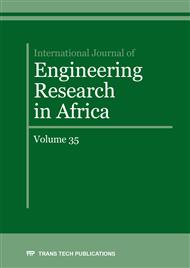[1]
Abderrahmani S, Maalem T and Hamadi D(2016); On Improved Thin Plate Bending Rectangular Finite Element Based On The Strain Approach, International Journal of Engineering Research in Africa, Vol 27, pp.76-86.
DOI: 10.4028/www.scientific.net/jera.27.76
Google Scholar
[2]
Belarbi M.T. et Charif A(1999)., Développement d'un nouvel élément hexaédrique simple basé sur le modèle en déformation pour l'étude des plaques minces et épaisses,, Revue Européenne des éléments Finis, Vol.8, N0 2, p.135157.
DOI: 10.1080/12506559.1999.10511361
Google Scholar
[3]
Belounar L et Guenfoud M (2005),"A New Rectangular finite element based on the strain approach for plate bending», Thin Walled Structures 43; 4763.
DOI: 10.1016/j.tws.2004.08.003
Google Scholar
[4]
François Frey(1998), Traité de génie civil de l'école polytechnique fédérale de Lausane – Volume 3– Analyse des structures et milieux continus – mécanique des solides, Presses polytechniques et universitaires romandes CH-1015.
DOI: 10.1080/03043799508928298
Google Scholar
[5]
HAMADI D., DERBANE S. and OUNIS A(2012)., "Formulation of A new plate bending finite element based on the strain approach ,international conference on applied and computational mathematics October , Ankara.
Google Scholar
[6]
Love A.E.H. (1988) On the small free vibrations and deformations of elastic shells. Philosophical trans of the Royal Society (London), Vol. s´erie A, N0 17 p.491–549.
Google Scholar
[7]
Mindlin R. D.(1951) Influence of rotatory inertia and shear on flexural motions of isotropic, elastic plates. Journal of Applied Mechanics, Vol. 18 p.31–38.
DOI: 10.1115/1.4010217
Google Scholar
[8]
Melosh, R.J.(1961) A stiffness matrix for the analysis of thin plates in bending, J. Aero-Space Sci., 28 pp.34-42.
Google Scholar
[9]
M. Himeur, M. Guenfoud (2011) « Elément fini flexionnel triangulaire doté d'un quatrième nœud fictif basé sur l'approche en déformation » Revue « Nature & Technologie ». n° 05/Juin. Pages 43 à 56.
Google Scholar
[10]
Reissner E(1945). The effect of transverse shear deformation on the bending of elastic plates. J. of Appl. Mech., Vol. 12 p. A69–A77.
DOI: 10.1115/1.4009435
Google Scholar
[11]
Timoshenko S(1921) On the correction of transverse shear deformation of the differential equations for transverse vibrations of prismatic bars. Philosophical Magazine, Vol. 41 (series 6) p.744–746.
DOI: 10.1080/14786442108636264
Google Scholar
[12]
Timoshenko S, Woinowsky-Krieger S (1959). Theory of plates and shells. London: McGraw-Hill.
Google Scholar
[13]
Uflyand Y.S. (1948) The propagation of waves in the transverse vibrations of bars and plates. Akad. Nauk. SSSR, Prikl. Mat. Mech., Vol. 12 p.287–300.
Google Scholar
[14]
ZIENKIEWCZ.O.C ET TAYLOR R.L (1991),The Finite Element Method, McGraw-Hill, London.
Google Scholar


